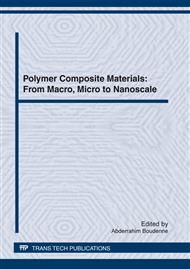p.67
p.73
p.79
p.85
p.91
p.99
p.115
p.123
p.131
Surface Modification of Nanosilica for PP Composites
Abstract:
Due to its high purity, favourable surface chemistry and huge specific surface area, fumed silica nanoparticlesare suitable inorganic nanoscopic templates for organic modification and nanocomposite studies. Polypropylene offers good properties with low or moderate cost for many technical applications, such as for solid dielectrics. Polypropylene and hydrophilic silica nanoparticles have inherently dissimilar surface chemistries and organic modification of the silica is usually needed to achieve good mixing and nanocomposite properties. Thetarget is to study robust grafting methods which can be up-scalable without complicated process steps. In thiswork nanosilica particleshave been modified by grafting to method using equimolar amounts of various chain lengths of vinyl functional polyisobutene (PIB) oligomers (molecular weights 320 g/mol, 920 g/mol and 2300 g/mol, determined by material supplier), further functionalized by epoxidation and subsequent reaction with organosilane.The glass transition temperature, viscoelastic properties and crystallization behaviour of the PP compositeswith PIB grafted silicas (4.5 wt% silica) were altered. Especially the PIB2300 grafted silica composite showed improved low temperature fracture toughness, significantly (14°C) lower glass transition measured by DMA and higher crystallization temperature compared to the pure polypropylene.
Info:
Periodical:
Pages:
91-98
Citation:
Online since:
March 2012
Authors:
Price:
Сopyright:
© 2012 Trans Tech Publications Ltd. All Rights Reserved
Share:
Citation:


